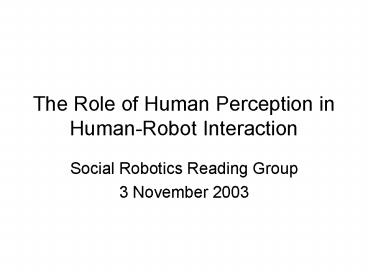The Role of Human Perception in HumanRobot Interaction PowerPoint PPT Presentation
1 / 19
Title: The Role of Human Perception in HumanRobot Interaction
1
The Role of Human Perception in Human-Robot
Interaction
- Social Robotics Reading Group
- 3 November 2003
2
Agenda
- All Robots Are Not Created Equal The Design and
Perception of Humanoid Robot Heads - Carl DiSalvo, Francine Gemperle, Jodi Forlizzi,
Sara Kiesler - Matching Robot Appearance and Behavior to Tasks
to Improve Human-Robot Cooperation - Jennifer Goetz, Sara Kiesler, Aaron Powers
- Discussion
3
Paper 1, All Robots Are Not Created Equal
overview
- Assumption A human-like head is desirable for
human-robot interaction - Valid? See paper 2!
- Question What makes a humanoid robotic head
more (or less) human-like? - Study Survey
4
Method
- Images of 48 robots from 3 categories
- Research (e.g. Pearl)
- Consumer Products (e.g. ASIMO)
- Fiction (e.g. Transformer)
- Images rated on a scale of 1 (Not very
human-like) to 5 (Very human-like) - 20 participants per survey
5
Analysis Presence of features
- Presence (or lack) of features is important
- Nose, Eyelids, Mouth
- Increase perception of humanness the most
- More features more human-like
6
Analysis Dimensions
7
Analysis Comparison to human head
- Prototypical human head average of
- Mona Lisa
- George Bush
- Michelangelos David
- Britney Spears
- Most human-like robots very similar dimensions
- Less human-like diverged
8
Conclusion Design Suggestions
9
How human-like is too human-like?
- The Uncanny Valley
- As a robot increases in humanness there is a
point where the robot is not 100 similar to
humans but the balance between humanness and
machine-like is uncomfortable.
10
Paper 2, Matching Robot Appearance and
Behavior overview
- Question How should service robots look and
behave, so that people comply? - Example getting elderly to exercise
- Three studies
- 1. Preferences for humanlike robots in jobs
- 2. Compliance with a playful or serious robot
- 3. Study 2 plus entertaining vs. serious task
- (Findings just presented at RO-MAN)
11
Study 1 Preferences for robots in jobs
- Three stages of humanlikeness
- Human
- Midstage
- Machine
- Male vs. female youth vs. adult (heads only)
- Survey which robot would be suitable for which
jobs? - Robots presented in pairs (which would be more
suitable for ltxgt?)
12
Study 1 results
- Humanlike preferred over machinelike
- Actress, drawing instructor (Artistic)
- Retail clerk, sales representative (Enterprise)
- Office clerk, hospital message carrier
(Conventional) - Aerobics instructor, museum tour guide (Social)
13
Study 1 results (continued)
- Machinelike preferred over humanlike
- Lab assistant, customs inspector (Investigative)
- Soldier, security guard (Realistic)
14
Study 2 Compliance with a serious or playful
robot,Background
- Positivity hypothesis
- More attractive, extroverted, cheerful robot will
have greater compliance - Matching hypothesis
- Appearance and behavior should match the
seriousness of the situation
15
Study 2 Method
- Pearl leads participant in exercise
- Playful Close your eyes Relax Breathe in
Dont forget to breathe out. I dont want you to
pass out! - Serious Close your eyes Relax Breathe in
Breathe out... Are you feeling relaxed? - Asked to exercise on own (as long as you can)
16
Study 2 Results
- Compliance how long the participant exercised
- Playful robot average of 25 seconds
- Serious robot average of 53 seconds
- Consistent with matching hypothesis
- Manipulation check
- Serious robot more conscientious, smarter
- Playful robot more playful and witty (and
obnoxious)
17
Study 3 Fun vs. Serious Task, overview
- 2x2 design
- Playful vs. Serious robot
- Fun vs. Serious task
- Tasks
- Serious Exercise task from study 2
- Slight change as many exercises as you can
- Fun Jellybean task
- Create recipes using gourmet jellybeans
- As many combinations as you can
18
Study 3 Results
19
Conclusions
- Match appearance and behavior to task
- More humanlike appearance seems better for
human-robot social interaction - Behavior needs to match task
- What thresholds are appropriate?
- How human in appearance?
- How playful/serious?

